In mid-December, I made a brief excursion to one of my favourite “short-trip destinations”: Jigokudani in the mountains of Central Honshu. Both Paveena and I have a deep affection for Japan: from the food to the culture, to the people to the landscapes – there is so much to love. In many ways it is the antithesis of China. The latter still has some amazing scenery but getting to and travelling around these places can be highly stressful. Japan is a place of ancient gods and customs but it is also the cutting edge of cool modernity. China has some of the former although much is suppressed and a small slice of the latter but in truth, it is no match for Japan where everything is ultra efficient, where everyone is charmingly courteous and where there is a tangible sense of history and cherished traditions. Throw in the sumptuous food, beautiful ryokens and relaxing onsens and even if you had little or no interest in its landscapes and wildlife, this would still be a great place to visit.
Japan has to have the world’s most efficient train system. Has a train ever been delayed in Japan? In the entire history of its railroads? Probably not. Hence getting around Japan is a breeze as was the case with my two hour train journey to Nagano followed by the 45 minute train to the town of Yudanaka. This ancient settlement still retains many old wooden buildings and its inhabitants are more likely to be seen wearing traditional Japanese attire than western clothing as one passes through its quaint narrow streets. The town is built over a system of thermal hot springs and this is its big draw card – the numerous onsens that can found in its ryokens and public bath houses.
Its other main attraction is the monkeys who bathe in the hot spring onsen at the nearby Monkey Park or Jigokudani Yaenkoen. To reach the park from my ryoken involved a simple 5 minute tax ride followed by a 30 minute hike through a beautiful snow-coved conifer forest. Around 200 Japanese Macaques live in the area. While no-one seems to be able to definitely confirm it, legend has it that the monkeys began to frequent the onsen during the early 1960s when a local ryoken owner took pity on them and left food out in winter. A special onsen (technically a rotemburo) was eventually built for them.
During the winter months when food is scarce, the park staff scatter barley seeds and apples into the rotemburo and the surrounding areas. The Macaques still spend the nights high up in the surrounding forest covered mountains, but in the winter months, large numbers appear in the daytime and spend most of the daylight hours in the park where they can be guaranteed food.
The Macaques have become so used to humans that they quite happily tolerate camera lenses only a few inches away from their faces. They will, on occasion make mock charges and pull aggressive facial expressions but unless you actually touch them, there is little danger.
In December 2008, I had visited the park with Paveena and had spent most of the time around the rotemburo where we got some great images – both wide-angle and close-ups of the Macaques, many of whom have remarkably human-like faces and mannerisms.
While I spent some brief periods at the rotemburo on this trip, I allocated most of time to firstly, the surrounding slopes which for two of my three days were bathed in sunshine during the midday hours. My second objective was to try and get some close-up, wide-angled shots of the Macaques jumping across the river.
The Macaques engage in a wide variety of intriguing behaviours. On the steep ice and snow enveloped mountain slopes, the young Macaques’ carefree play can be witnessed as they climb trees, cavort and roughhouse. Nearby, mothers cuddle babies and adults affectionately groom one another.
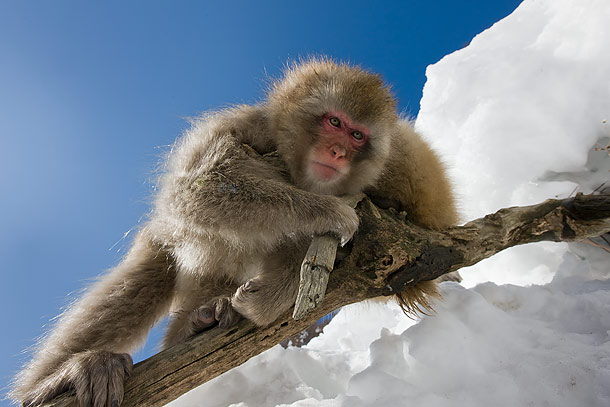
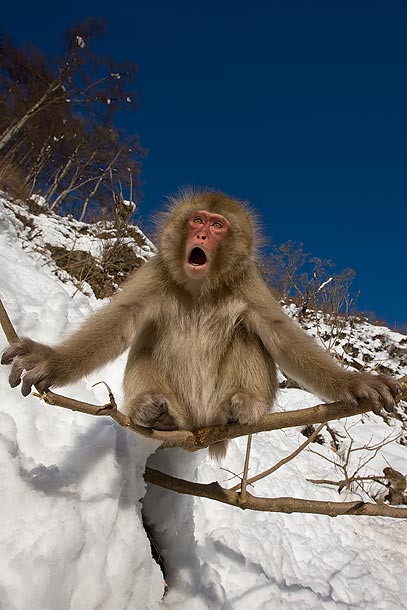
Cigarette break?
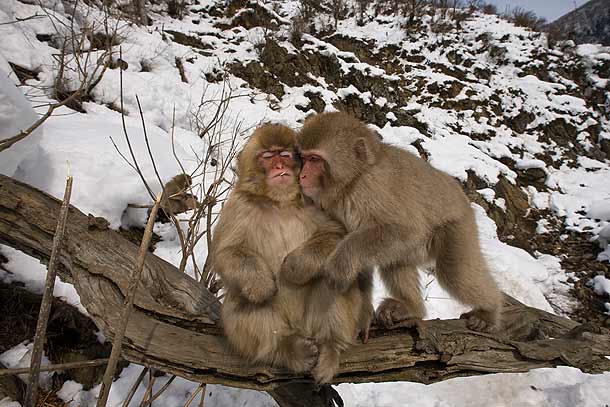
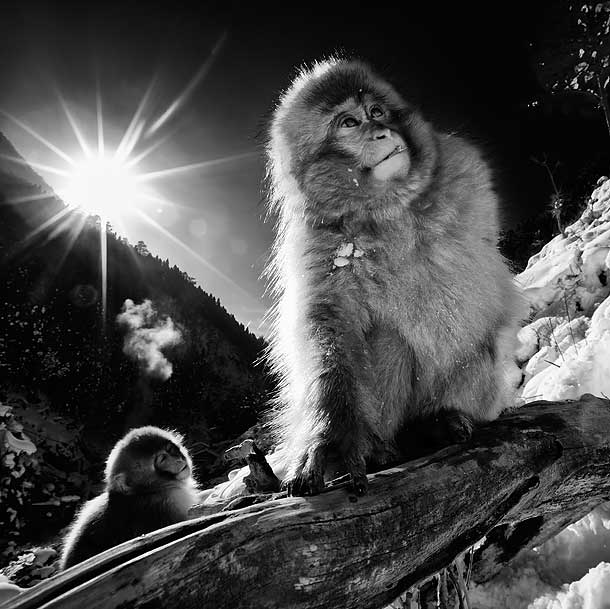
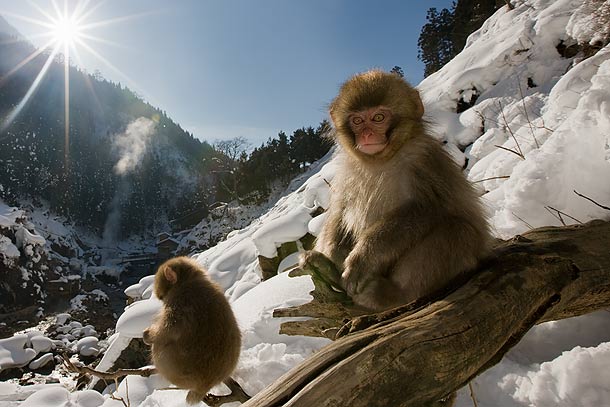
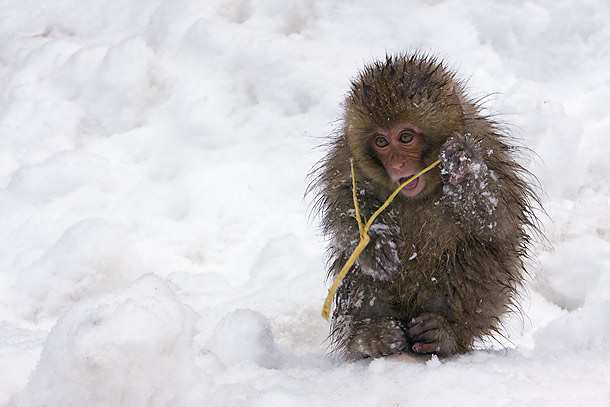
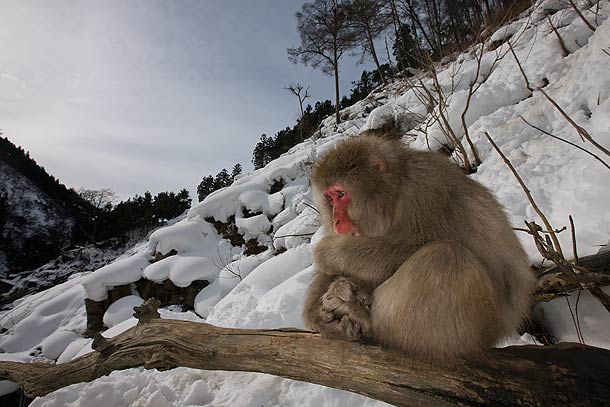
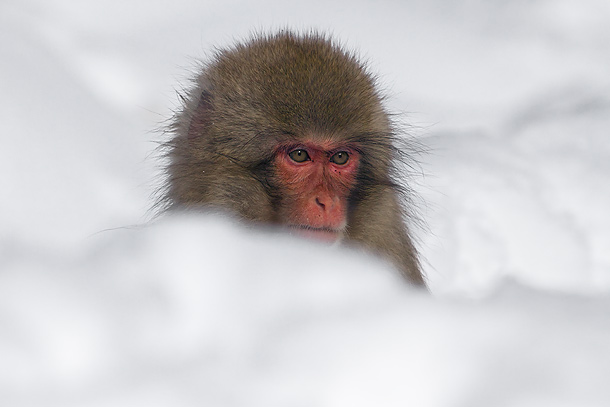
Even in the sun, temperatures are still below freezing with mothers and babies and sometimes whole families huddled tightly together in an effort to stay warm.
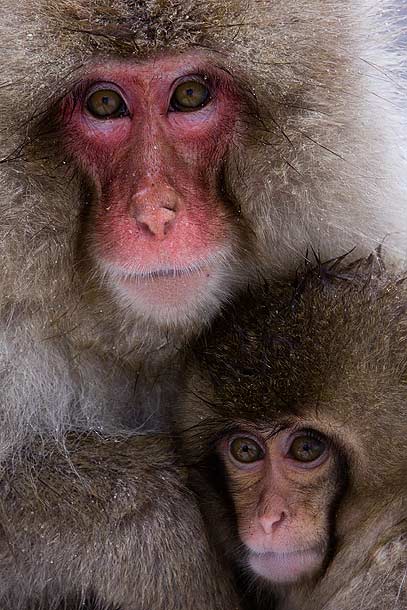
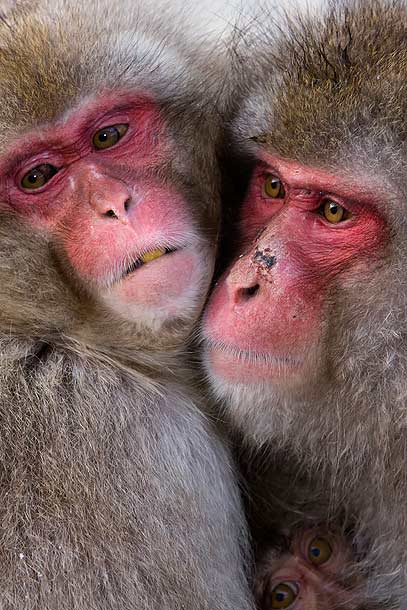
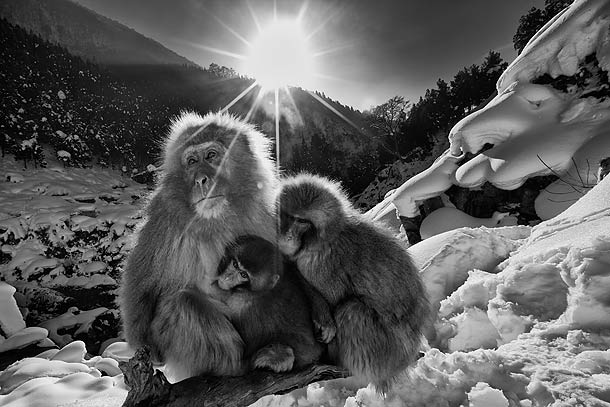
When I was last in Jigokudani, I had observed that the Macaques would occasionally hurl themselves across the small, but fast flowing river that runs through the park. Like all primates, they are incredibly dexterous with ice-covered, slippery rocks proving no impediment as a launch pad to propel themselves to the other side.
Most of the crossings take place in a brief interval at the outset of feeding time (3x daily) when the park’s wardens scatter seeds on the snow and rocks beside the river. Through careful observation, I could see that the Macaques had certain favoured crossing points. However, from my experience, if you positioned yourself at the river’s edge beside their exit point, they tended to shy away. So I had come with a man-made rock casing which served the purpose of disguising the camera in order not to spook the Macaques. I would then stand 20 meters away and use a wireless trigger to trip the camera shutter. There are many difficulties with this technique, not least that you need to set the lens to manual focus and then guess in advance the distance from the camera to the leaping Macaque at the time the photo is taken. Secondly, because of the low light conditions, some element of fill flash would be needed to illuminate the Macaque. The degree of fill flash would also have to be guessed at in advance. The rock casings were not designed to accommodate an on-camera flash meaning that an off-camera flash would be needed by using a flash sync cord. The biggest problem though was the unbelievable speed at which the Macaques would launch themselves across the river. Even using an ISO of 800, I was constantly fighting to achieve sufficient shutter speed to freeze the motion of the Macaques. In addition, the wireless transmitter was often ever so slightly slow in reacting to the downward pressure of my finger – or so it seemed; the reality was that it was simply my slow reactions.
I spent a number of bone chilling hours waiting for the Macaques to cross. When they did, I was mostly too slow with lots of images of their back legs. After three days I had to largely admit defeat and these two shots were the best I could come up with.
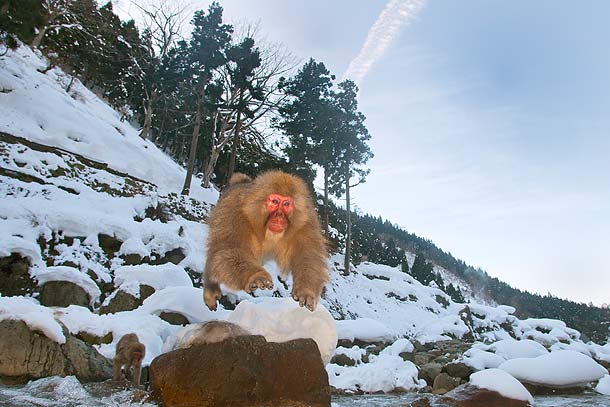
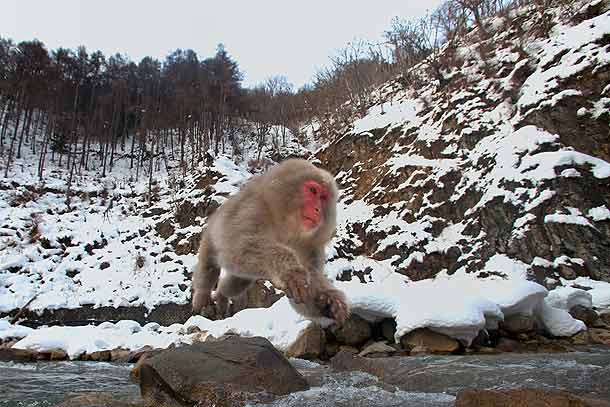
On the fourth day, I just had time for 90 minutes at the park before rushing to catch my train back to Tokyo. So for old time’s sake, I headed back to the rotemburo.
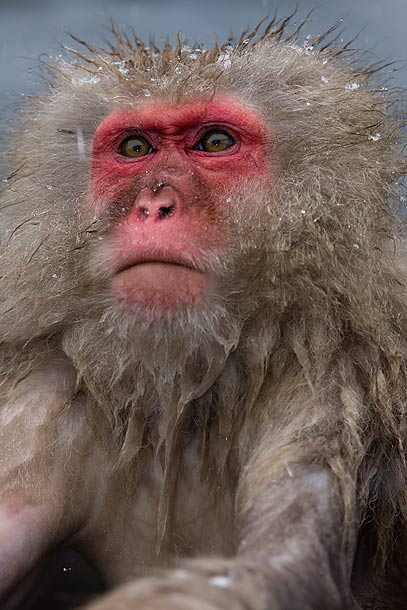
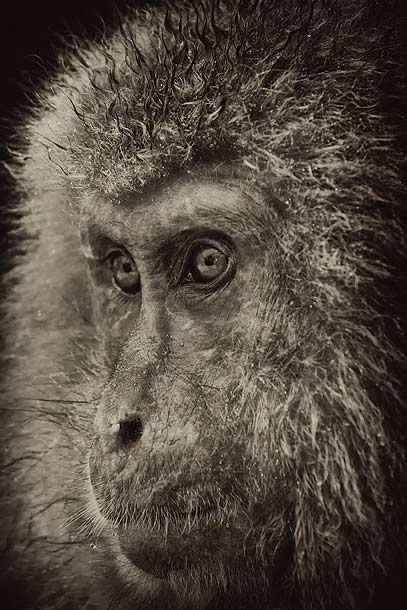
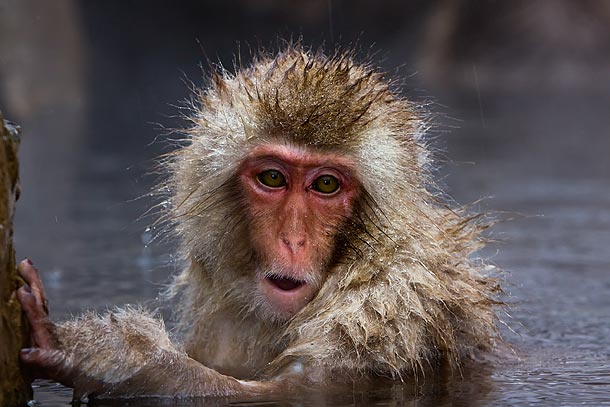
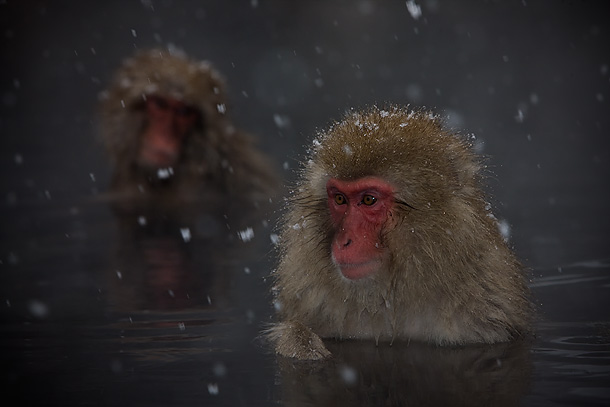
The leaping Macaques have now become a bit of an obsession of mine, so I have promised myself another trip next year. However, before that, Paveena and I are bound for the eastern half of Hokkaido, Japan’s frigid, northern-most Island this weekend. We are both really looking forward to this adventure with the combination of its winter landscapes and unique wildlife promising plenty of outstanding photo opportunities.
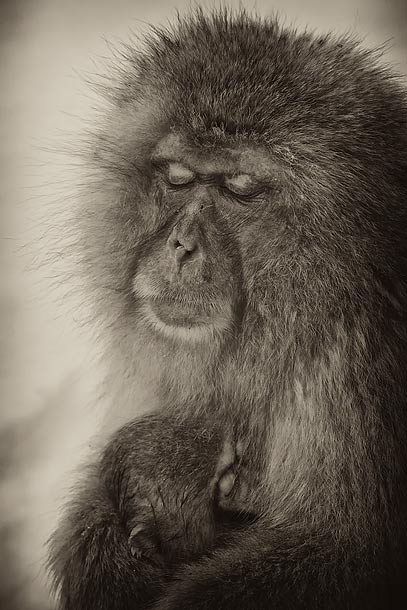
jattinn kochhar
February 10, 2010
these are simply awesome paul ! both the kids luv these pics. when r u guyz planning a trip to india?
Colin Stewart
February 10, 2010
Very nice series, Paul. I too went to Jigokudani in late January and stayed at the excellent ryokan you recommended. Thank you. I continue to enjoy your updates very much. Wishing you well. CS
Susie
February 12, 2010
I like the ones with the snow macaques sitting on the branches against the snowy background the best. Very nice details. Hope your enjoying your next trip to Japan.
Ross McKenzie
February 17, 2010
Hokkaido, where I spent a year, is I think my favourite place in terms of natural beauty. You need to do winter and autumn there. You’ll love it.